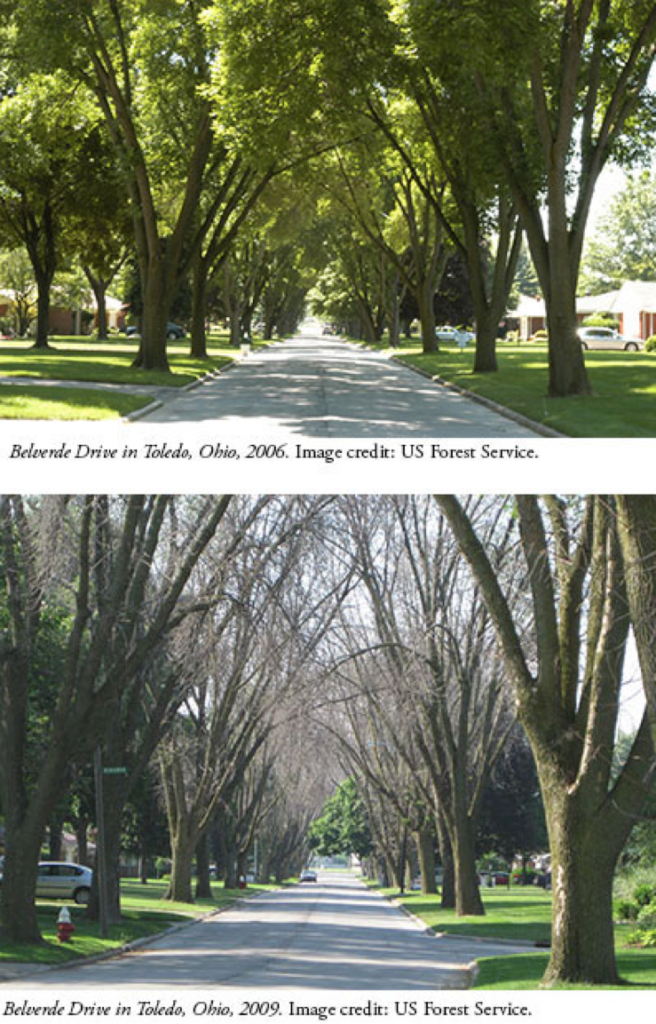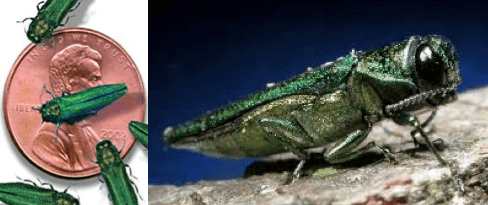New Jersey Department of Agriculture officials confirmed that the emerald ash borer (EAB), an invasive insect that attacks and kills ash trees, has been found in Somerset County. Samples were confirmed by the US Dept. of Agriculture.
The adult emerald ash borer is a metallic green insect about one-half inch long and one-eighth inch wide, making it difficult to detect in the wild. Female beetles lay eggs on the bark of ash trees. The eggs hatch and the larvae bore into the bark to the vascular system underneath. The larvae feed and develop, cutting off the flow of nutrients and, eventually killing the tree. EAB attacks and kills North American species of true ash, and tree death occurs 3-5 years following the initial infestation. You can learn more about the invasive emerald ash borer here.

Peters-Todd’s Inc. has been working closely with researchers and chemical company representatives to put together the best programs to keep our clients’ trees protected. Treatments are best done preventively. Chances of survival are greatly reduced once the insects get into the tree. We are currently finalizing our program and will begin to implement our treatments shortly. Most treatments afford either one or two years of protection, therefore, this will need to be repeated on a proper schedule to ensure adequate protection.
We will be measuring trees and putting together proposals for high profile ash trees throughout the main living areas of our clients’ properties. If you’ve got ash trees that you want to protect, call us now. For those clients with wooded properties, contact us and we’ll help to come up with the best management plan for your property and budget. If you have any questions about your ash trees or EAB, please give us a call.
Do your ash trees have any of these symptoms?
- Canopy dieback beginning at the top of the tree and progressing through the year until the tree is bare
- Sprouts growing from the roots and trunk
- Split bark with S-shaped galleries below
- D-shaped exit holes
- Increased woodpecker activity, creating large holes as they extract larvae
To prevent the spread of the beetle, DO NOT MOVE FIREWOOD! Firewood is a vehicle for movement of tree- killing forest pests including EAB and Asian longhorned beetle. Use locally-sourced firewood when burning at home or travelling. When travelling, either use all wood purchased or leave the unused portion behind.
Please call our office at 908.204.9918 to have an Arborist inspect your property today, so we can protect it tomorrow!
What if yo u do nothing?

Ash Trees are at High Risk
2022 has been a turning point in EAB detection. Over the winter, we’ve seen trees seemingly transformed before our eyes. A typical ash tree has distinct greyish brown bark. However, over late winter into early spring, we noticed that ash trees were changing colors to a lighter blondish color. This is because we are seeing bark missing along the entire trunks and limbs. This “blonding” is a common symptom of advanced infestation by EAB caused by woodpeckers removing the outer bark as they search for EAB larvae and pupae. To learn more about this “blonding” and what you should do on your property, read our updated blog here.
